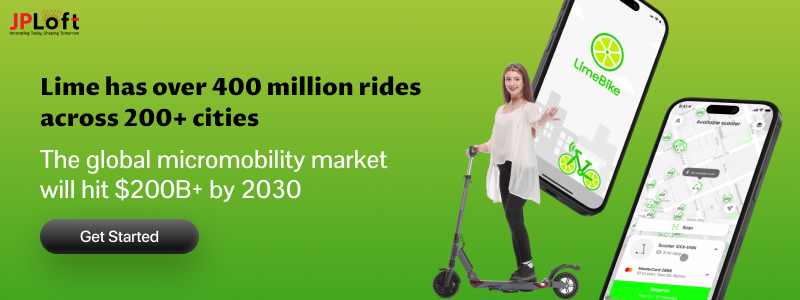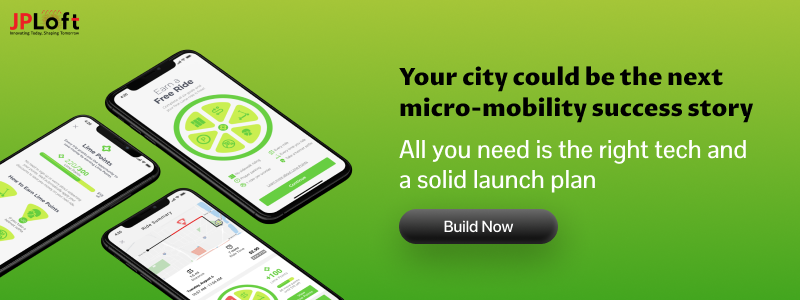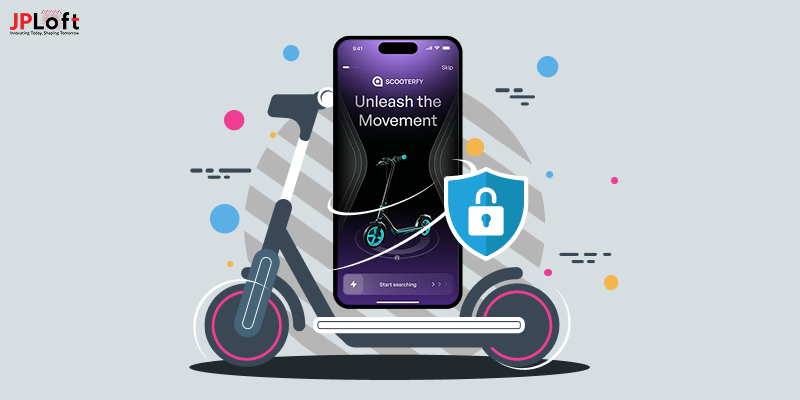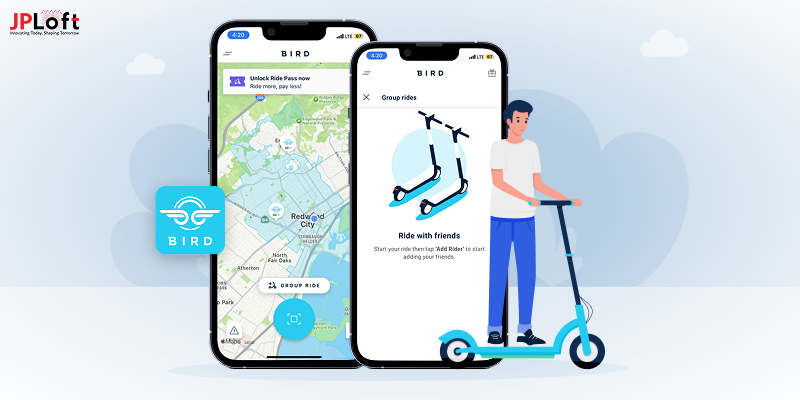With eco-friendly and on-demand transportation options, the urban mobility scene is drastically changing, and Lime is leading the charge. In just a few taps on their smartphones, users can easily locate, unlock, and ride e-scooters seamlessly. Promoting convenience, sustainability, and freedom of movement.
Building an app like Lime is all about tapping into the future of smart cities and eco-friendly short-distance transportation, offering real-time GPS tracking, IoT integration, and contactless payments. Whether you are a startup, mobility entrepreneur, or a transportation agency, developing a Lime-like app could be the next big step for your company's success.
In this blog, we will explore everything about developing an app like Lime, including its core features, the ideal tech stack, cost breakdown, and challenges, so you can confidently enter the thriving industry of micromobility.
Key Takeaways:
The eScooter sharing market is projected to reach USD 2.4 billion by 2029 with a continuous annual growth of 5.12%.
Lime has revolutionized short-distance urban transportation by offering ride tracking and eco-friendly e-scooter rentals with the ease of a few taps on their mobile device.
Core features include QR-powered unlocking, real-time GPS tracking, battery management, ride history, in-app payment, and a powerful admin dashboard.
A robust development cycle includes market research, UI/UX design, the right tech stack selection, testing, and post-launch maintenance.
The development cost of the eScooter app varies between USD 50,000 to USD 250,000, depending on the features and development complexity.
JPLoft offers full-cycle development services from ideation to deployment with expertise in mobility app development, IOT, and scalable app solutions.
About Lime: Ride Green
Lime is a leading eScooter sharing platform that has transformed the way people travel short distances in the city. Users can locate, unlock, and ride electric scooters using the Lime e-scooter sharing app, all from the comfort of their phone. With GPS-enabled scooters and seamless payment integration, Lime ensures a smooth and efficient experience.
Core idea of the business to develop an app like Lime was to provide clean, green rides, reducing traffic congestion, cutting carbon emissions, and promoting sustainable transportation. By offering zero-emission rides, it supports cleaner air and less noise pollution in urban areas, covering almost 100 cities worldwide for casual and daily short-distance rides.
Why Develop an App like Lime?
Make an app like Lime to boost your business in the green-mobility sector and offer diverse opportunities for generating revenue and scalability. Let's take a look at the recent escooter app statistics and impactful factors behind them:
1. Urbanization and Increased Population in Cities
Statistic: The global urban population is expected to rise to 68% by 2050, as estimated by the United Nations.
Factors: As densely populated cities grow, worsening the traffic congestion, lack of parking space, and public transit options, people will move towards services like Lime, providing an efficient and scalable solution for short-distance traveling
2. Sustainability and Climate Awareness
Statistic: According to The Lime Times, micro-mobility services like Lime have helped avoid 10 million trips, reducing thousands of tons of CO₂ emissions.
Factors: Consumers and governments are increasingly concerned about carbon emissions and climate change. Switching to e-scooters for micromobility has reduced the negative environmental impact of short-distance travel.
3. Technological Advancements in Connectivity
Statistic: It has been estimated by Statista that the global micro-mobility escooter market size was USD 5.85 billion in 2020 and is expected to grow to USD 21.69 billion by 2030.
Factors: Advancements in mobile technology, 5G fast networking, GPS tracking, and IoT allow for efficient fleet management, fast bookings, real-time location tracking, and seamless payment systems, making micro-mobility escooter apps more user-friendly.
4. Changing Consumer Preferences for Convenience
Statistic: According to Nielsen, 74% of consumers are more likely to purchase and choose sustainable and eco-friendly traveling options.
Factors: Younger generations, particularly Millennials and Gen Z, prioritize on-demand services, convenience, sustainability, and flexibility in transportation. These trends fuel the demand for services like Lime.
5. Investments and Industry Revenue
Statistic: As reported by The Lime Times, the micro-mobility escooter app Lime raised USD 420 million in revenue by the year 2020.
Factors: Venture capital investment in green technologies and micro-mobility solutions has grown significantly, with large investors and governmental partnerships backing up the escooter rental app startups like Lime.
6. Regulatory Support and Partnerships
Statistic: It has been estimated by Statista, the micromobility market is expected to grow at a CAGR of 14.8% from 2020 to 2030.
Factors: Many governments realized the importance of eco-friendly micromobility in reducing congestion and pollution, introducing dockless parking zones and exclusive lanes for the bikes and escooters. Partnerships between escooter companies like Lime and local governments have made it easier for the micromobility services to thrive.
Develop an eScooter app like Lime to help in providing sustainable, eco-friendly, hassle-free, short-distance rides to urban city users. Escooter app ideas make budget-friendly green rides more accessible to users, also benefiting travel agencies and startups.
After learning about the benefits of eScooter apps, let's take a look at how to create an app like Lime and how it works.
How Does an App like Lime Work?
Develop an app like Lime that allows users to locate, unlock quickly, and rent shared electric eScooters for short urban trips. Here's a step-by-step breakdown of how these best escooter apps work for a user and their code features, and how you can build a Lime clone to replicate this success:
1] Download and Sign Up
Users download the app on their respective devices (iOS or Android) and sign up with their email, phone number, or social accounts. Payment methods are added before booking their first ride.
2] Locate a Vehicle
Launch the app to see a map of the nearby eScooters and bikes that are available right now based on GPS tracking. The app will display the necessary information before booking, such as walking distance to the nearby electric scooters, estimated travel time, and battery life.
3] Unlock the Ride
To start a ride, users will have to scan the QR code located on the eScooter using an in-app scanner or enter the vehicle’s unique plate number. Riders with Apple App Clips or Android Instant Apps can quickly unlock the scooter without having to download the full app.
4] Ride and Navigate
Users can ride anywhere within the defined geofence set by the eScooter company. The app will provide directions, ride tracking, information on ride zones like speed or parking rules, and battery status.
5] End the Ride
On reaching the destination, riders have to park the eScooter responsibly, following the local parking guidelines. Tap on ‘End Ride’ and submit a photo of the properly parked vehicle.
6] Payment and Ratings
The fare is automatically deducted from the rider's selected online payment method and is calculated based on the unlocking fee and per-minute charges, and rate their experience after the ride.
In just a few taps on their mobile phone, riders can easily book an electric scooter for their daily or casual short-distance travel on the go. Now let's check out the core and advanced features that can be integrated to build an eScooter app like Lime.
Features to Include in an App like Lime
Create an eScooter sharing app like Lime with a focus on user convenience, safety, and effective fleet management. Simplifying on-demand urban mobility through sophisticated GPS tracking, QR/IoT unlocking, and smooth in-app payments.
Here is a list of the most crucial escooter app features to integrate when you create an app like Lime. These features are considered best practices and are key to current market success:
|
Features |
Description |
|
Registration and Onboarding |
Quick, secure sign-up with email, phone, or social media. Guides/ tutorials for onboarding. |
|
Profile Management |
Personal info, add payment methods, ride history, manage rewards, and loyalty points |
|
Interactive Map and Real-Time GPS Tracking |
Locate nearby available eScooters. Live GPS for security and ride tracking. |
|
QR Smart Unlock |
Unlock the eScooter with QR scanning. Manual code entry in case of QR scan failure. |
|
Ride Booking |
Immediate or advanced booking of one or more escooters. |
|
Battery Management and Safety |
Displays the eScooter's battery percentage and estimated range. Gives e-scooter safety instructions and geofencing limitations. |
|
In-App Payments and Ride History |
Secure and seamless in-app payment with total fare breakdown. List ride history. |
|
Push Notifications and Customer Support |
Send alerts for battery, promotions, ride status, and safety. In-app FAQs and customer support chat for quick responses. |
|
Admin/Dashboard Panel |
Access to real-time fleet, rider, and ride management with analytics. Tools for operational management. |
Implementing these features guarantees to provide a competitive, easy-to-use, and scalable micro-mobility solution that satisfies contemporary urban mobility and safety standards. After listing the important core features that are a must-have for a Lime-like app, we'll next see how to build an app like Lime.
How to Create an App like Lime?
An app like Lime requires methodical, strategic planning to create an eScooter app that strikes a balance between business requirements, technical stability, and user experience.
Here's a detailed step-by-step outline for how to develop an eScooter sharing app like Lime, based on the industry's best practices:
Step 1. Market Research and Value Proposition
To start an e-scooter rental app business, analyze your targeted cities, urban transportation availability patterns, competitors' offerings, and user pain points. Define your escooter rental app's unique value proposition, which may include eco-friendliness, pricing flexibility, advanced safety, etc.
Step 2. Feature Selection and MVP Planning
Identify core essential features to develop a mobile app like Lime, which may include user registration, real-time GPS tracking, QR code unlocking, in-app payments, battery management, ride history, and an admin dashboard. Set a budget to manage the cost to create an app like Lime. Start with an MVP (minimum viable product) to launch faster and gather user feedback for enhancements in the final app development.
Step 3. Designing UI/UX
Start lean, focus on the fundamental requirements, and carefully design escooter app UI using real user requirements or create a Lime clone. Use seamless navigation, clear information, and visually appealing designs to facilitate and improve user adoption and retention.
Step 4. Choosing the right Tech Stack
-
Backend: Node.js or Python; Database: PostgreSQL or MongoDB.
-
Frontend: Swift for iOS, Kotlin for Android, or use cross-platform frameworks like Flutter or React Native for a simultaneous iOS/Android rollout.
-
Integrations: Google Maps (maps/tracking), Stride/PayPal (payment), and IoT protocols (smart locks).
Step 5. Platform Selection and App Development
Depending on the targeted market and the company budget, choose between native and cross-platform development. Build an eScooter app like Lime with core components such as the user interface, administration panel, fleet management, and IoT safety integrations.
Step 6. Testing
Maintain the safety of app users by conducting security validation checks, testing of integrations, real-world user testing, and unit testing. Ensure all bugs are resolved, and performance is optimized to prevent a negative user experience after launch.
Step 7. Deployment and Launch
Publish the app to Google Play and the Apple App Store after meeting all the compliance and licensing requirements for the app. Create a launch plan that includes marketing, public relations, and user onboarding strategies.
Step 8. Continuous Maintenance and Enhancement
Regularly monitor user feedback, usage data, and app analytics to fix issues, roll out updates, and scale operations. Frequently update features like promotions and loyalty programs, and maintain server security and compliance.
By following these basic, easy steps, we understand how to build an app like Lime. Ensuring that the eScooter app trends are developed to be robust, user-friendly, and scalable for long-term urban mobility demand. But have you wondered how AI, the trendy advancement in tech, could help your app become even better? Well, in the next section, we will go through how AI integration can level up a Lime-like app.
Can AI Be Used to Develop an App like Lime? How!
Integration of AI-powered features can significantly enhance the development and operation when you develop a Lime clone, introducing smarter, more efficient, and personalized capabilities for both users and operators.
Here's how AI could help develop a mobile app like Lime for the current market:
A] Personalized User Experience
AI personalizes the safest and fastest routes based on live traffic, ride history, requirements, and real-time city data, improving rider satisfaction. The system tailors offers, rewards, and recommendations based on each rider's usage pattern.
B] AI-powered Safety Enhancement
Advanced AI analyzes sensor and geolocation data to enforce geofencing and alerts users about no-ride or slow-speed zones. Detects the rider's unsafe behavior and initiates proactive safety interventions. Real-time hazard detection and reporting system integrated with augmented reality to ensure safe rides.
C] Fleet and User Insights for Operators
Operators receive actionable dashboards powered by AI that aggregate and visualize rider behavior, fleet usage, and citywide movement trends. This helps in optimizing the riders’ requirements, business growth, and urban planning decisions.
D] Enhanced Customer Support
AI-powered customer support chatbots provide 24/7 multilingual assistance for common user queries, preventing customers from having to wait for help. They can also troubleshoot, assist with lost and found, and collect feedback with minimal human intervention.
E] Augmented Reality (AR) Integration
AI supports AR navigation, making it easier for users to find their rented eScooters, understand parking locations, and interact with micro-mobility features. This will help in improving ease of use and user engagement.
Introducing AI, with the help of an AI app development company, to build a Lime clone could automate operational decisions, personalization, and overall empower smarter and sustainable, eco-friendly rides.
Next, let’s go through what's the cost to build an eScooter app like Lime, including the integration of such AI features and overall development expenses.
What's the Cost to Build an App like Lime?
The price typically depends on several factors, like design and development complexity, tech stack, platform choice (iOS, Android, or both), feature set, development team location, and scalability requirements.
The cost to develop an app like Lime can go from $50,000-$250,000+. However, an MVP of the electric scooter rental app may cost between $8,000 to $14,000; a simple app with basic features and a single platform costs around $50,000; and a complex, feature-rich, scalable e-scooter rental app may cost around $250,000+.
We have tabulated the complete breakdown of the development cost of an eScooter app:
|
Component |
Estimated Cost (USD) |
|
UI/UX Design |
$5,000–$15,000 |
|
Rider App (iOS & Android) |
$20,000–$70,000 |
|
Admin Panel |
$10,000–$25,000 |
|
Backend Development (APIs, DB) |
$15,000–$40,000 |
|
Scooter IoT Integration |
$10,000–$30,000 |
|
Real-Time GPS & Map Integration |
$5,000–$15,000 |
|
Payment Gateway Integration |
$3,000 – $10,000 |
|
Testing & QA |
$5,000–$15,000 |
|
Total (Basic to Advanced App) |
$50,000 – $250,000+ |
Develop an eScooter app like Lime by ensuring proper budget planning, aligned with your desired functionality, platforms, integrations, and geographic targets—whether you're building a basic MVP or a large-scale solution.
After understanding the costs of app development, let's now see how we can utilize the app and optimally monetize it for revenue.
How to Monetize an App like Lime?
Monetizing a micro-mobility app, such as a Lime-like e-scooter sharing app, is crucially important for maintaining sustainability and scalability.
The reason to create an eScooter sharing app like Lime, for businesses, typically relies on a blend of direct user charges, value-added services, strategic partnerships, and data-driven opportunities.
Here we provide you with the most successful escooter app business models of the current market, inspired by Lime.
1. Per-Minute/Per-Ride Charges (Pay-per-Use)
This is the core model followed by most of the successful revenue-generating eScooter renting app models. Users usually pay as per the use of eScooters, generally with an unlocking fee plus per-minute charges.
2. Subscription Plans
This model is more popular among frequent and daily riders, providing discounted ride bundles for users who purchase packages upfront. It offers unlimited rides of up to a certain duration or distance per day/ week/ month for a certain recurring fee for the riders.
3. Dynamic Pricing
This model includes adjusting the ride fare based on high demand for booking eScooter rides. Generally, these fares rise during special events like festivals, during rush hours, or in busy locations, maximizing revenue generation during peak periods.
4. In-App Ads
This model promotes third-party businesses by providing space for banner ads on the eScooter booking app. They push notifications or feature locations on a map, based on the fee paid.
5. Aggregate Data Sales
Sell anonymized mobility of riders and traffic data to city planners, advertisers, urban researchers, or transportation authorities, all while protecting users' privacy.
6. In-app Upsells
This model promotes the user for purchases of ride requirements, such as helmet rental, insurance, priority access, or some customization demand, during the booking process of the ride.
An app like Lime's successful monetization strategy blends customer convenience, adjustable prices for all kinds of riders, and several sources of income. Partnering with a tech company can help with escooter app development challenges and make a Lime clone into a sophisticated, long-term, tech-powered mobility platform.
Your App, Our Expertise: Partner with JPLoft
Ready to launch the next big thing in the micro-mobility industry? Partner with JPLoft to build an eScooter rental app similar to Lime and transform your vision into a market-leading, tech-enabled reality.
With urban transportation shifting rapidly towards eco-friendly, smart, and sustainable solutions, it's high time to enter the eScooter sharing space.
From concept to code, JPLoft delivers full-cycle development with in-depth market research, intuitive UX/UI, seamless payment systems, real-time GPS tracking, and a robust fleet management dashboard. Our expertise in mobility platforms, IoT integrations, and cutting-edge app design ensures your app is a tailored solution built for your business.
Choose JPLoft, the best e-scooter app development company, as your partner now because your app needs expertise powering the leaders of micromobility. And enjoy continuous support, regular updates, and flexibility to enhance your app with the latest trends.
Conclusion
Building an eScooter rental app like Lime offers a compelling opportunity to enter the fast-growing micro-mobility market. With the right monetization strategy and approach, developers and entrepreneurs can capitalize on multiple revenue streams through the app.
Integration of core features like real-time GPS tracking, QR/IoT unlocking, and in-app seamless payment is crucial for user satisfaction. And using AI along with these features would only make the app even more sustainable and foster stronger user engagement and retention.
Launching a Lime-like app gives your business a push towards the mobility revolution, delivering economic, environmental, and social value. Paving the way for a smarter, greener, and more connected urban future.
FAQs
To build a Lime-like app, create user and admin interfaces, integrate GPS tracking, real-time scooter availability, QR code unlocking, and payment processing. Use IoT-enabled scooters, backend services for fleet management, and map APIs.
The development costs range from USD 8,000 for a basic MVP to USD 250,000+ for a feature-rich, scalable solution. The costs of developing such apps depend on complexity, platforms, and integrated advanced features.
AI enables smarter fleet management, rider-personalized routes/offers for users, dynamic pricing, hazard detection, alerts for geofencing, and 24/7 chatbot support for general queries, resulting in higher sustainability and a better user experience.
For the development of the frontend, use Swift (iOS) or Kotlin (Android); for the backend, use PostgreSQL or MongoDB; integrate maps with Google Maps; add a payment system with Stripe or PayPal; and use IoT for the smart locking system.
A simple version of the escooter rental app with basic features and minimal complexities may take up to 2-5 months. While developing a full-scale, full-featured app can require 8-10 months or more, depending on your requirements and development resources.













Share this blog